Eating & Nutrition for Hemodialysis
On this page:
- How does what I eat and drink affect my hemodialysis?
- How can I learn what I should eat?
- Do I need to watch what I eat and drink?
- Why is it important to keep track of how much liquid I eat or drink?
- What foods count as liquid and why?
- What is my dry weight?
- What do I need to know about potassium?
- What do I need to know about phosphorus?
- What do I need to know about protein?
- What do I need to know about sodium?
- What do I need to know about calories?
- Should I take vitamin and mineral supplements?
- Points to Remember
How does what I eat and drink affect my hemodialysis?
Your choices about what to eat and drink while on hemodialysis can make a difference in how you feel and can make your treatments work better.
Between dialysis treatment sessions, wastes can build up in your blood and make you sick. You can reduce waste buildup by controlling what you eat and drink. You can match what you eat and drink with what your kidney treatments remove.
Some foods cause wastes to build up quickly between your dialysis sessions. If your blood contains too much waste, your kidney treatment session may not remove them all.
How can I learn what I should eat?
Your dialysis center has a renal dietitian to help you plan your meals. A renal dietitian has special training in caring for the food and nutrition needs of people with kidney disease.
Use this information to help you learn how to eat right to feel right on hemodialysis. Read one section at a time. Then, review with your renal dietitian the sections marked “Talk with Your Renal Dietitian.”
Keep a copy of this information handy to remind yourself of foods you can eat and foods to avoid.
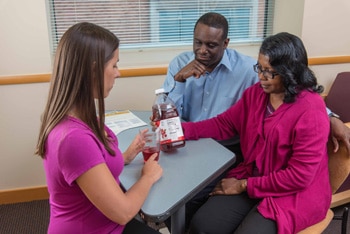
Do I need to watch what I eat and drink?
Yes. You will need to carefully plan your meals and keep track of the amount of liquids you eat and drink. It helps to limit or avoid foods and beverages that have lots of
- potassium
- phosphorus
- sodium—for example, vegetable juice and sports drinks
Why is it important to keep track of how much liquid I eat or drink?
You may feel better if you keep track of and limit how much liquid you eat and drink. Excess fluid can build up in your body and may cause
- swelling and weight gain between dialysis sessions
- changes in your blood pressure
- your heart to work harder, which can lead to serious heart trouble
- a buildup of fluid in your lungs, making it hard for you to breathe
Hemodialysis removes extra fluid from your body. However, hemodialysis can remove only so much fluid at a time safely. If you come to your hemodialysis with too much fluid in your body, your treatment may make you feel ill. You may get muscle cramps or have a sudden drop in blood pressure that causes you to feel dizzy or sick to your stomach.
Your health care provider can help you figure out how much liquid is right for you.
One way to limit how much liquid you have is to limit the salt in the foods you eat. Salt makes you thirsty, so you drink more. Avoid salty foods such as chips and pretzels.
Your renal dietitian will give you other tips to help you limit how much liquid you consume while making sure you don’t feel too thirsty.
What foods count as liquid and why?
Foods that are liquid at room temperature, such as soup, contain water. Gelatin, pudding, ice cream, and other foods that include a lot of liquid in the recipe also count. Most fruits and vegetables contain water, such as melons, grapes, apples, oranges, tomatoes, lettuce, and celery. When you count up how much liquid you have in a day, be sure to count these foods.
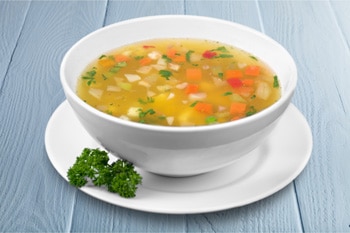
What is my dry weight?
Your dry weight is your weight after a hemodialysis session has removed all extra fluid from your body. Controlling your liquid intake helps you stay at your proper dry weight. If you let too much fluid build up between sessions, it is harder to achieve your dry weight. Your health care provider can help you figure out what dry weight is right for you.
My dry weight goal: _____________.
Talk with Your Renal Dietitian
Even though you are on hemodialysis, your kidneys may still remove some fluid. Or, your kidneys may not remove any fluid at all. Work with your renal dietitian to set a goal for how much liquid you can have each day. Keep track of the liquids you drink and other foods you eat.
I can have a total of _____ ounces of liquid each day.
Daily plan:
I can have _____ ounces of ______________ with breakfast.
I can have _____ ounces of ______________ in the morning.
I can have _____ ounces of ______________ with lunch.
I can have _____ ounces of ______________ in the afternoon.
I can have _____ ounces of ______________ with supper.
I can have _____ ounces of ______________ in the evening.
TOTAL: _______ ounces. This number should equal the goal that you set with your renal dietitian.
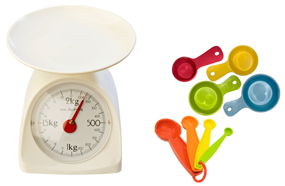
What do I need to know about potassium?
Healthy kidneys keep the right amount of potassium in your blood to keep your heart beating at a steady pace. Potassium levels can rise between hemodialysis sessions and affect your heartbeat. Eating too much potassium can be dangerous to your heart and may even cause death.
To control potassium levels, limit potassium-rich foods such as avocados, bananas, kiwis, and dried fruit. Choose fruits and vegetables that are lower in potassium. Have very small portions of foods that are higher in potassium, such as one or two cherry tomatoes on a salad or a few raisins in your oatmeal.
You can remove some of the potassium from potatoes by dicing or shredding them and then boiling them in a full pot of water.
To remove some of the potassium from potatoes:

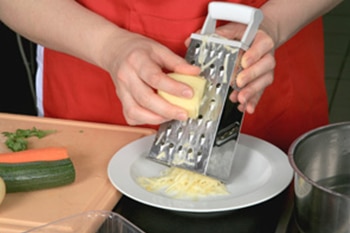
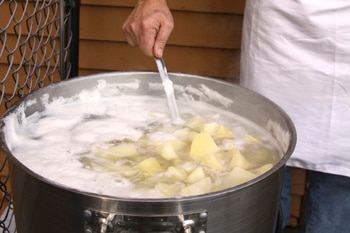
Your renal dietitian will give you more specific information about the potassium content of foods.
Talk with Your Renal Dietitian
Make a food plan that reduces the potassium in your diet. Start by noting the high-potassium foods you currently eat. Your renal dietitian can help you add foods to the list.
Changes
Talk with your renal dietitian about foods you can eat instead of high-potassium foods.
Instead of _________, I can eat _________.
Instead of _________, I can eat _________.
Instead of _________, I can eat _________.
Instead of _________, I can eat _________.
More information is provided in the NIDDK health topic, Potassium: Tips for People with Chronic Kidney Disease.
What do I need to know about phosphorus?
Too much phosphorus in your blood pulls calcium from your bones. Losing calcium may make your bones weak and likely to break. Also, too much phosphorus may make your skin itch. Limiting phosphorus can be hard because foods that contain phosphorus, such as meat and milk, also contain the protein you need. You should be careful to eat enough protein; however, not so much that you get too much phosphorus. Processed and packaged foods contain especially high levels of phosphorus. You can also find phosphorus naturally in foods such as poultry, fish, nuts, peanut butter, beans, cola, tea, and dairy products. Usually, people on hemodialysis should only have a 1/2 cup of milk per day. Your renal dietitian will give you more specific information about phosphorus.
You may need to take a phosphate binder such as sevelamer (Renvela), calcium acetate (PhosLo), lanthanum carbonate (Fosrenol), or calcium carbonate to control the phosphorus in your blood between hemodialysis sessions. These medicines act like plastic bags with zip tops. The phosphorus binder “seals” the phosphorus from food and moves it out through stool so the phosphorous does not enter the bloodstream.
Talk with Your Renal Dietitian
Limiting phosphorus and getting enough protein can be difficult. See the “Talk with Your Renal Dietitian” section under the next section about protein.
More information is provided in the NIDDK health topic, Phosphorus: Tips for People with Chronic Kidney Disease.
What do I need to know about protein?
Renal dietitians encourage most people on hemodialysis to eat high-quality protein because it produces less waste for removal during dialysis. High-quality protein comes from meat, poultry, fish, and eggs. Avoid processed meats such as hot dogs and canned chili, which have high amounts of sodium and phosphorus.
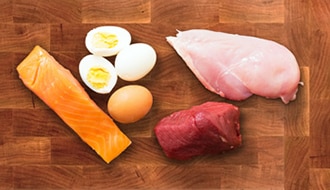
Talk with Your Renal Dietitian
Talk with your renal dietitian about the meats you eat.
I will eat ______ serving(s) of meat each day. A regular serving size is 3 ounces, about the size of the palm of your hand or a deck of cards.
Try to choose lean, or low-fat, meats that are low in phosphorus, such as chicken, fish, or roast beef. If you are a vegetarian, ask about other ways to get protein.
Low-fat milk is a good source of protein. However, milk is high in phosphorus and potassium. Milk also adds to your liquid intake. Talk with your renal dietitian to see if milk fits into your food plan.
If milk is in my food plan, I will drink ______ cup(s) of milk a day.
More information is provided in the NIDDK health topic, Protein: Tips for People with Chronic Kidney Disease.
What do I need to know about sodium?
Sodium is a part of salt. Sodium is found in many canned, packaged, frozen, and fast foods. Sodium is also found in many condiments, seasonings, and meats. Too much sodium makes you thirsty, which makes you drink more liquid.
Try to eat fresh, naturally low-sodium foods. Look for products labeled “low sodium,” especially in canned and frozen foods.
Do not use salt substitutes because they contain potassium. Talk with your renal dietitian about spices you can use to flavor your food. Your renal dietitian can help you find spice blends without sodium or potassium.
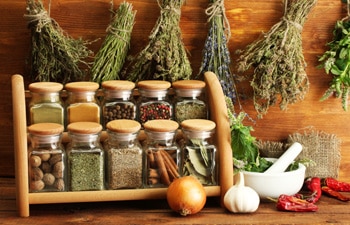
Talk with Your Renal Dietitian
Your renal dietitian can help you find spices and low-sodium foods you might like. List them here:
Spice: ________________
Spice: ________________
Spice: ________________
Food: ________________
Food: ________________
More information is provided in the NIDDK health topic, Sodium: Tips for People with Chronic Kidney Disease.
What do I need to know about calories?
All foods contain calories, and you need calories for energy. Many people on hemodialysis do not have a good appetite and do not get enough calories. If you find you do not feel like eating, talk with your renal dietitian to find healthy ways to add calories to your diet. Vegetable oils—such as olive oil, canola oil, and safflower oil—are good sources of calories and are the healthiest way to add fat to your diet if you need to gain weight. Use them generously on breads, rice, and noodles only if your renal dietitian tells you to add calories to your diet.
Butter and margarines are rich in calories; however, they are mainly saturated fat. Saturated fats and trans fats can clog your arteries. Use them less often. Soft margarine that comes in a tub is better than stick margarine. Choose a soft margarine with less saturated and trans fats.
Talk with your renal dietitian about the types and amounts of fat you need in your diet. Everyone will have different needs that a renal dietitian can help address.
Hard candy, sugar, honey, jam, and jelly provide calories and energy without fat or adding other things that your body does not need. If you have diabetes, be careful about eating sweets and talk with your renal dietitian before adding sweets to your food plan.
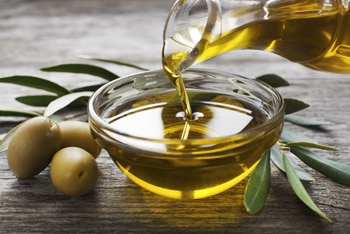
If you are overweight, your renal dietitian can work with you to reduce the total calories you eat each day.
Talk with Your Renal Dietitian
Everyone’s calorie needs are different. You might need to cut down on calories if you are overweight, or you might need to find ways to add calories to your diet if you are losing weight without trying. Talk with your renal dietitian about how many calories are right for you.
I will get ____ calories every day.
More information is provided in the NIDDK health topic, Food Label Reading: Tips for People with Chronic Kidney Disease.
Should I take vitamin and mineral supplements?
You may not get enough vitamins and minerals in your diet because you have to avoid so many foods. Hemodialysis also removes some vitamins from your body. Your health care provider may prescribe a vitamin and mineral supplement designed specifically for people with kidney failure.
Warning: Do not take nutritional supplements you can buy over the counter. These supplements may contain vitamins or minerals that are harmful to you. For safety reasons, talk with your health care provider before using probiotics, dietary supplements, or any other medicine together with or in place of the treatment your health care provider prescribes.
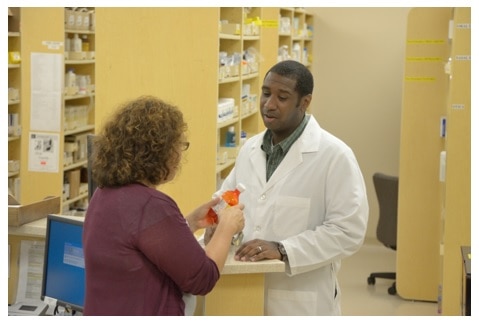
More information is provided in the NIDDK health topic, Eating Right for Kidney Health: Tips for People with Chronic Kidney Disease.
Points to Remember
- Your choices about what to eat and drink while on hemodialysis can make a difference in how you feel and can make your treatments work better.
- Between dialysis treatment sessions, wastes can build up in your blood and make you sick. You can reduce waste buildup by controlling what you eat and drink.
- It helps to limit or avoid foods and beverages that have lots of
- potassium
- phosphorus
- sodium—for example, vegetable juice and sports drinks
- You may feel better if you keep track of and limit how much liquid you eat and drink.
- Hemodialysis removes extra fluid from your body. However, hemodialysis can remove only so much fluid at a time safely. If you come to your hemodialysis with too much fluid in your body, your treatment may make you feel ill. You may get muscle cramps or have a sudden drop in blood pressure that causes you to feel dizzy or sick to your stomach.
- Potassium levels can rise between hemodialysis sessions and affect your heartbeat. Eating too much potassium can be dangerous to your heart and may even cause death.
- Too much phosphorus in your blood pulls calcium from your bones. Losing calcium may make your bones weak and likely to break.
- Renal dietitians encourage most people on hemodialysis to eat high-quality protein because it produces less waste for removal during dialysis. High-quality protein comes from meat, poultry, fish, and eggs.
- Sodium is a part of salt. Sodium is found in many canned, packaged, frozen, and fast foods. Sodium is also found in many condiments, seasonings, and meats. Too much sodium makes you thirsty, which makes you drink more liquid.
- Everyone’s calorie needs are different. You might need to cut down on calories if you are overweight, or you might need to find ways to add calories to your diet if you are losing weight without trying.
- You may not get enough vitamins and minerals in your diet because you have to avoid so many foods. Your health care provider may prescribe a vitamin and mineral supplement designed specifically for people with kidney failure. For safety reasons, talk with your health care provider before using probiotics, dietary supplements, or any other medicine together with or in place of the treatment your health care provider prescribes.
More Online Information
The American Association of Kidney Patients provides many articles for people with chronic kidney disease and people on hemodialysis.
The National Kidney Foundation offers many brochures, cookbooks, and fact sheets for patients with kidney disease.
This content is provided as a service of the National Institute of Diabetes and Digestive and Kidney Diseases
(NIDDK), part of the National Institutes of Health. NIDDK translates and disseminates research findings to increase knowledge and understanding about health and disease among patients, health professionals, and the public. Content produced by NIDDK is carefully reviewed by NIDDK scientists and other experts.
The NIDDK would like to thank:
Judith Beto, Ph.D., R.D., Loyola University Healthcare System

